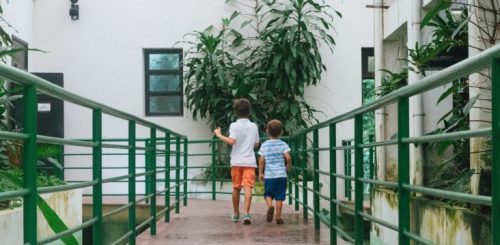
5 Ways Modern Education Revolutionized Traditional Teaching Methods
February 10, 2023Traditional teaching methods are fading away, and new, modern educational methods are here to empower the next generation of movers and shakers! These days, students are front and center, with the ability to create an educational experience that suits their learning styles.
Technology is changing the modern educational experience, and 73% of students will continue online courses long after the pandemic. Today, we’ll take a deeper look at how modern education forever changed traditional teaching methods.
Modern vs. Traditional Teaching Methods
Of course, there’s no right or wrong way to learn, but some educators would argue that certain teaching methods are better than others. Let’s start by defining modern and traditional teaching methods so that you can incorporate both into your lesson plans.
What are Traditional Teaching Methods?
Traditional teaching methods are typically implemented in a physical classroom setting. In this learning model, the teacher is the primary source of instruction. The teacher controls the course curriculum, teaching methodology, and learning environment. However, traditional teaching methods follow a rote memorization method that doesn’t work for every student.
What are Modern Teaching Methods?
Modern education differs from traditional teaching methods because it puts the student experience first. The shift to remote learning, edtech innovations, and changing ideas about pedagogy are the reasons for educational changes. Modern teaching methods such as the “flipped classroom” and inquiry-based learning allow students to learn at their own pace. In addition, these modern teaching methods encourage students to think critically about the information they’re receiving.
The Most Important Advancements in Traditional Teaching Methods
Modern education isn’t perfect – but it’s getting better every day with the help of innovative educators! Today’s students need more than an old textbook and flashcards to get excited about learning. Let’s learn more about how traditional teaching methods are evolving.
1. eLearning is the Focal Point of Many Lesson Plans
Whether you host your classes online or in a physical classroom, eLearning is integral to the modern educational experience. Traditional teaching methods center around the student experience in a physical classroom, but with eLearning, students can utilize their devices to find new information, collaborate with other students, and shape their educational experience.
2. Active Learning is Essential for Student Engagement
Modern teaching is activity-based, which sparks student engagement through interactive learning experiences. Unlike traditional teaching methods, students are encouraged to engage directly with the learning process through class discussions and hands-on projects. When you incorporate opportunities for active learning within your lesson plans, students internalize information better and understand how they can apply the knowledge they learned in school to the real world.
3. Deep Learning and Critical Thinking are Encouraged
Wherever there’s active learning, deep learning can be found as well. In the simplest terms, deep learning occurs when students take information from a situation and apply it to another subject. Consequently, students flex their critical thinking skills while learning to communicate with others.
When your students are exploring learning materials and fully involved in their educational experience, they’re more engaged from interacting directly with the materials. Furthermore, deep learning encourages students to develop an academic mindset that will serve them well after formal education.
4. Soft Skills are Becoming More Important
Today’s teaching methods allow students to develop the soft skills that will support them in adulthood rather than memorize information from a textbook. While technical skills are still valuable, soft skills such as critical thinking, problem-solving, and the ability to work with others are the tools that allow students to thrive in the modern world. In the future, students will rely on technology to do most of the heavy lifting, while their soft skills enable them to climb the corporate ladder.
5. Students Require a Personalized Approach to Learning
With traditional teaching methods, every student was expected to learn the same way, using the same lesson plans. However, educators are taking a personalized approach to teaching in the quest to create a more inclusive learning environment. As a result, modern, student-centric teaching methods allow students to reap the benefits of a personalized educational experience.
Digital devices and edtech software make it possible for students to interact with learning materials in a highly personalized manner. Modern education acknowledges that every student learns differently and gives them the tools to learn in their way.
6. Students Want to Share Their Knowledge
More than ever before, students desire a progressive learning environment in which they can confront real-world problems through the lens of academia. With increased access to technology comes greater access to information that transcends language barriers and socio-economic issues.
Moreover, modern students want to share their opinion with others. When you bring exciting edtech software into your classroom, students can share their creations with others through digital mediums, like websites or social media.
5 Ways to Improve Traditional Teaching Methods
You can add a little pizazz to your lesson plans, even if you’re a traditionalist at heart! These five simple tips will show you how to leverage edtech tools for a modern twist on traditional teaching methods.
1. The Flipped Classroom
Regarding traditional teaching methods, educators typically introduce topics and encourage students to study in their free time outside of class. In contrast, a “flipped classroom” is where students learn about a particular subject independently. Then, they join forces in the classroom to solve problems, ask questions, and collaborate with peers.
The flipped classroom method encourages students to participate actively in their education and develop greater autonomy. Additionally, the flipped classroom creates a safe space for students to discover more about their preferred learning styles.
2. VAK Learning
The term “VAK” learning refers to the three types of understanding styles, which include visual, auditory, and kinesthetic learners. Visual learners absorb information best when they’re able to view information (textbooks, infographics, charts), auditory learners prefer to hear information (videos, discussions, podcasts), and kinesthetic learners perform physical activity to learn something as active participants.
The best part is you can incorporate all three types of learning in a single lesson with the right tools. For example, you can use Soundtrap for Education with our Shakespeare and Hip-Hop lesson plan to help students understand classical literature. In this lesson plan, visual learners will absorb the information through reading the text, while auditory learners can better understand Shakespeare by listening to the sonnets with music. Meanwhile, kinesthetic learners will deepen their knowledge by repeating the sonnet aloud.
3. Project-Based Learning
Project-based learning is another fun way for students to get excited about learning! This modern educational method enables students to synthesize theoretical information and apply it to a hands-on project. With project-based learning, students learn how to solve problems that are applicable to the real world.
There are plenty of creative ways to bring project-based learning to your classroom. For instance, encourage students to express the connection between music and their well-being or teach students how to code with audio loops. Depending on the subject, your students can work on projects individually or in small groups.
4. Collaborative Learning
Most traditional teaching methods encourage students to work by themselves. However, collaborative learning requires students to work together, which allows them to develop soft critical skills such as time management, collaboration, delegation, and social skills. Furthermore, collaborative learning exercises enable students to develop self-awareness to evaluate their strengths and weaknesses.
Collaborating with groups of students in the classroom can be challenging, especially when working with limited time. Fortunately, cloud-based EdTech tools like Soundtrap for Education allow students to collaborate from any device at any time for a flexible, collaborative learning experience.
5. Inquiry-Based Learning
Today’s students expect personalized teaching strategies that differ significantly from the one-size-fits-all approach of traditional teaching methods. Inquiry-based learning allows students to learn at their own pace. Most inquiry-based projects begin when the teacher poses an open-ended question, and students do their research to form a theory.
You might ask students to complete these activities independently or in groups. With inquiry-based learning, you can lead the investigation process or let the class experiment with their approach. Through inquiry-based learning, students develop their analytical and reasoning skills.
Revolutionize Your Curriculum with Soundtrap for Education
Soundtrap for Education is the ultimate audio production platform for students and teachers to create and edit audio recordings. Pupils and educators can easily tap into their artistic side with this intuitive audio platform that facilitates a creative learning environment for every subject, regardless of the student’s age or experience level.
With Soundtrap for Education, students and teachers can collaborate with advanced cloud technology at any time or place. In addition, the platform comes equipped with a robust resource portal, with tutorials, an external curriculum, and lesson plans to complete the educational experience. And to ensure privacy, teachers can ensure that student collaboration is safe and secure with invite-only groups in Soundtrap’s versatile digital environment.
If you’re ready to enhance your educational experience with an intuitive cloud-based audio production platform, get started today with Soundtrap for Education! And be sure to share this article with other teachers in your network to help spread the joy of learning through sound.
 EDU Portal
EDU Portal


